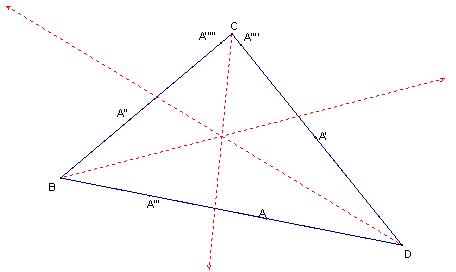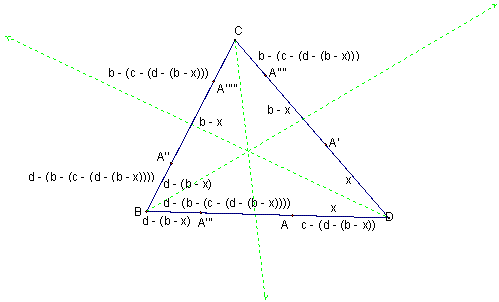- About MAA
- Membership
- MAA Publications
- Periodicals
- Blogs
- MAA Book Series
- MAA Press (an imprint of the AMS)
- MAA Notes
- MAA Reviews
- Mathematical Communication
- Information for Libraries
- Author Resources
- Advertise with MAA
- Meetings
- Competitions
- Programs
- Communities
- MAA Sections
- SIGMAA
- MAA Connect
- Students
- MAA Awards
- Awards Booklets
- Writing Awards
- Teaching Awards
- Service Awards
- Research Awards
- Lecture Awards
- Putnam Competition Individual and Team Winners
- D. E. Shaw Group AMC 8 Awards & Certificates
- Maryam Mirzakhani AMC 10 A Awards & Certificates
- Two Sigma AMC 10 B Awards & Certificates
- Jane Street AMC 12 A Awards & Certificates
- Akamai AMC 12 B Awards & Certificates
- High School Teachers
- News
You are here
Creating Mathematical Experience in the Classroom - Return Times of Reflected Points
Shortly after the question of the CSR was posed, I posed a second open question to the students. I first saw this question on the CSU, Chico Department of Mathematics Web page, posted as a challenge question for high school geometry students. According to Jim Jones, Professor of Mathematics at CSU, Chico, no responses were ever received. It has since been replaced by other challenge problems.
I had used the question on several different occasions to illustrate the potential of GSP. The Dynamic Geometry students, save one, first saw the question on their take-home midterm. Each student was instructed to work independently on the question. The student who had seen the problem before was able to draw from that experience, but this did not adversely affect her or the class’s experience.
Construct a triangle and an arbitrary point on one side. Moving in a counterclockwise direction, reflect the point across the angle bisector of the adjacent angle. Continuing to move in a counterclockwise direction around the triangle, reflect the new point across the next angle bisector. Continue this process. Make and prove conjectures on whether this process will eventually lead back to the original point. Looking at specific types of triangles may lead to partial or additional results.
Figure 4: Reflection over Angle Bisectors
Click on the title for the JavaSketchpad version. If you have Geometer's Sketchpad, you can download and run the GSP file.
My class of 19 students generated a substantial list of conjectures from this one question. In my role of coordinator, I modified the language but not the main thrust of the various conjectures, and I supplied the following list and instructions to the class. For instance, I introduced the term “return time” to replace the various ways the students described the number of reflections until the point was reflected back to its original position.
A great deal of work has been done on the third problem on the take-home portion of the midterm. In this problem, a point on the side of a triangle is successively reflected across the angle bisectors. This problem is being moved over to the domain of the class project since there seems to be substantive work left. Here I will attempt to list the results so far. This list was quickly compiled, so the person cited was the person on whose paper I first saw the conjecture. My apologies to those who independently made the same or similar conjectures. I will attempt to rectify this in future updates. Since these results were obtained from the take-home exam, they do not count for credit towards the individual’s project grade; however, continued work will. I did not have time to determine which of these conjectures were proven.
Conjectures
- All points on all triangles have a return time of at most six (C. Rojas, et al).
- The mid-point of a side of an equilateral triangle has a return time of three (D. Taylor).
- The mid-point of the base of an isosceles triangle has a return time of three (B. Campoy).
- Every side of a triangle has a point whose return time is three (C. Rojas).
- In a triangle, the three points whose return time is three are the three points of tangency of the inscribed circle (L. Cooke).
- The points formed by the successive reflections of a point are co-circular (C. Finzell)
- Reflecting points across the angle bisectors is equivalent to rotating these points around a point centered at the incenter of the triangle (F. Rocha).
- A point, its reflection across an angle bisector, and the vertex of the angle form an isosceles triangle (C. Tedder).
- The reflection of a point on the side of an angle across the angle bisector will lie on the line containing the other side of the triangle (D. Taylor).
- The vertex of an equilateral triangle will have a return time of five (D. Taylor).
- The point on the side of an isosceles triangle whose distance from the vertex is equal to the distance of the point on the second side formed by the intersection of the angle bisector has a return time of three (B. Campoy).
- The vertex of an equilateral triangle has a return time of four (B. Campoy).
- Given triangle ABC and point X on segment AB, the distance of X to B must be less than the length of BC for the point’s reflection across the angle bisector of B to lie on segment BC (B. Campoy).
There were indeed proofs and partial proofs contained in students’ work. The following suggested proof was supplied by C. Rojas, who was the one student who had seen this problem when I used it in a previous course. In later communication with me, she indicated that her previous exposure to the problem and the proof then outlined guided her in her work.
Consider
with sides
of lengths
, respectively. (See Figure 5.) Select point
on side
and label the distance from
to vertex
as
. The image of
under a reflection across the angle bisector of
,
, is also a distance
from
, and therefore a distance
from vertex
.
As a consequence,
, the image of
under a reflection across the angle bisector of angle
, is a distance
from vertex
, and a distance
from vertex
.
The next reflection across the angle bisector of
, results in a point,
, whose distance from
is
.
This is followed by a second reflection across the angle bisector of
, resulting in a point
whose distance from
is
.
The next reflection is across the angle bisector of angle
, and the image,
, is a distance
.
The sixth and final reflection, across the angle bisector of angle
, results in a point
whose distance from
is
, therefore returning
to the position occupied by the original point
.
Figure 5: Return Time of 6 in a General Triangle
The class was generally impressed by this argument and considered it a valid proof. This provided an opportunity to examine the assumptions underlying the argument.
For instance, the argument assumes that the images of the points under reflection will lie on the line containing the side of the triangle. Since this can be proven -- in fact was proven by several students -- it provided an example of the role of lemmas in mathematical proofs as well as an understanding of the importance of dialog between mathematicians.
A second issue, one that was not raised in class, is the assumption that all points lie on the sides of the triangle as opposed to the lines containing the sides. In other words, there is an assumption that each subtraction results in a positive value. Since a simple adjustment can be made in Rojas’ argument to address this issue, her argument is substantially correct.
Another student, D. Taylor, approached the problem from a different perspective. He first proved the following lemmas.
Lemma: The reflection of a point on the side of an angle across the angle bisector will lie on the line containing the other side of the angle.
Lemma: A point and its reflections are all equidistant from the incenter of the triangle.
Lemma: The composition of the reflections across two concurrent lines is equivalent to a rotation about the point of intersection.
These lemmas led to a proof of the theorem, and in subsequent class discussions the class consensus was that this proof was superior to the first. It not only led to a generalization of the results to n-gons with concurrent angle bisectors, but it suggested a fundamental switch in perspective. The issue was not one about points on the side of a triangle being reflected across angle bisectors, but about arbitrary points being reflected across concurrent lines. The fact that the concurrent lines happened to be angle bisectors of a triangle whose side contained the initial point was seen as incidental.
A number of students had already investigated related questions. C. Lambie had conjectured that a general point taken on the interior or exterior of the triangle had a return time of 6. C. Finzel, M. Elliot, and B. Salam had made the same conjecture about reflections across perpendicular bisectors, altitudes, and medians of a triangle. The class noted with appreciation that all of these conjectures were special cases of a more general theorem that reflections about concurrent lines will have a return time related to the number of lines.
Others, such as L. Miller, had found experimentally that for most (non-regular) quadrilaterals, the reflection points did not return, and that the cases in which they did return were precisely the cases were the angle bisectors were concurrent. We felt as though we had come closer to the deeper, more essential, relationship.
We briefly discussed the question of return times less than 6. It was not clear if D. Taylor’s proof would account for these, but apparently C. Rojas’ proof could. D. Garber then analyzed D. Taylor’s proof and claimed to have shown how return times of 5 and 3 could be accounted for, at least in certain cases. There were others who investigated those points that had a return time of less than 6, finding that there exist points with a return time of 5 (M. Hellman, M. Elliot, C. Tedder).
One last area of contribution was an attempt to systematize the results of the point-reflection investigations. This proved to be very challenging and led to a class activity in which various groups presented suggested systems. These were of various degrees of sophistication but led to a general realization that, in order to systematize the results, one needs to know a proof of each of the results. The discussion ended with a recognition of the role proof plays in systematization of mathematical theorems (de Villiers, 1999).
Jorgen Berglund, "Creating Mathematical Experience in the Classroom - Return Times of Reflected Points," Convergence (September 2005)






